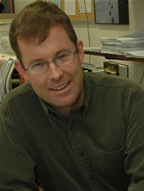Campus Focuses on Sustainability
Resolution Seeks Integration into Curriculum
January 7, 2008
By Pamela McLaren
A resolution passed this month by the Academic Senate urges the campus to increase sustainability efforts not only in the physical maintenance and development of Cal State Fullerton, but into all aspects of campus life, including teaching and research.
“The amount of interest is high,” said A. Scott Hewitt, professor of chemistry and biochemistry, who chaired the senate’s Ad Hoc Sustainability Committee. “Sustainability is not just about environment or a concern for global warming, but it also can help reduce costs and provide opportunities for growth.”
In his Dec. 6 presentation to the Academic Senate, Hewitt reported that more of an emphasis on sustainability could offer benefits for all members of the campus, including provide job, research, internship and service-learning opportunities for students; increase interactivity with local and regional community groups, including sister institutions and cities; reduce long-term operating costs; and create fundraising opportunities.
The resolution urges the campus to create a sustainability task force to “increase awareness of sustainability and build faculty capacity to support sustainability efforts on our campus and in the community,” to direct the task force to coordinate efforts to incorporate sustainability throughout the curriculum and to work with campus members to institutionalize sustainability at Cal State Fullerton.
The charge to set up a committee to research sustainability was approved at the Academic Senate’s last meeting of the spring semester. Among its activities, the committee surveyed full- and part-time faculty members about interest in and incorporation of sustainability into courses, researched what other higher education institutions are doing and brought a sustainability consultant to campus as part of a two-day series of lectures and workshops on the issue.
The committee acknowledged the university’s current efforts, including recycling 60 percent of all campus waste; upgrading of lighting, heating and cooling systems; increasing use of energy from alternative or green sources; use of electric vehicles on campus and ‘green’ cleaning products (see related story above). The campus also offers more than 50 courses in 14 departments that incorporate sustainability.
In addition, Hewitt reported that a University Sustainability Study Group was established this fall through a Mission and Goals Initiative to delve into the issue.
“We envision that Cal State Fullerton will have a sustainability director, a sustainability office and a sustainability advisory board,” the report concluded as its long-term vision for the campus. “Sustainability will be an integral part of some courses and a general education requirement. Other courses will incorporate sustainability modules, assignments and projects. Perhaps there will be a sustainability minor or a sustainability degree. Faculty, students, staff and community members will be working together on sustainability projects. Perhaps we will create a sustainability institute that focuses on sustainability research and outreach.”
Members
of the senate Ad Hoc Sustainability Committee are:
Chair: A.
Scott Hewitt, professor of chemistry and biochemistry
Faculty: Pinaki
R. Chakrabarti, chair and professor of civil and environmental engineering;
Rebecca E. Dolhinow, assistant professor of women’s studies; Nancy
Jimeno, lecturer in political science; H. Jochen Schenk, assistant professor
of biological science; and Jonathon S. Taylor, associate professor of
geography.
Staff: Gregory
Dyment, director of the Fullerton Arboretum
Administration: Willem
van der Pol, director of physical plant
Students: Anthony
Martinez, Associated Students Inc. chief governmental officer; and Marlene
Nang, sustainability coordinator for California State University Chancellor’s
Office.
Unofficial student representatives: Gina van Deth, chair
of the campus Environmental Action & Advocacy Committee, and Allen
Morton.


